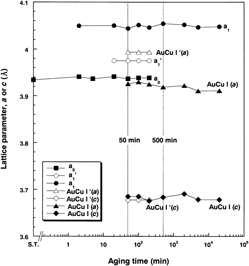Published online by Cambridge University Press: 12 April 2013

The hardness changes caused by formation of the metastable and stable phases were examined and correlated with the microstructural changes in grain interior and grain boundary during aging at 350 °C to clarify the age-hardening and softening mechanism of a low-gold Au-Cu-Ag-Pd dental alloy. Aging in this context refers to the time-delay that occurs wherein such alloys are kept at elevated temperatures for periods upto many hours to allow precipitation or ordering to take place. During the period of increasing hardness, the matrix was separated into the Ag-rich α1 and AuCu I phases through the metastable phases, forming block-like structure. The apparent hardening was attributed primarily to lattice strain due to the tetragonality of AuCu I′ [the primer (′) here indicates a metastable phase; likewise (I) and (I′) indicate stable AuCu I and metastable AuCu I′ phases, respectively] and AuCu I phases along the c-axis, secondarily to the coherency or semicoherency strain between the metastable α1′ and AuCu I′ phases and between the α0 and AuCu I phases along the a-axis. The apparent softening was caused primarily by growth and coarsening of the lamellar structure in the grain boundaries, secondarily by coarsening of the block-like structure in the grain interior.